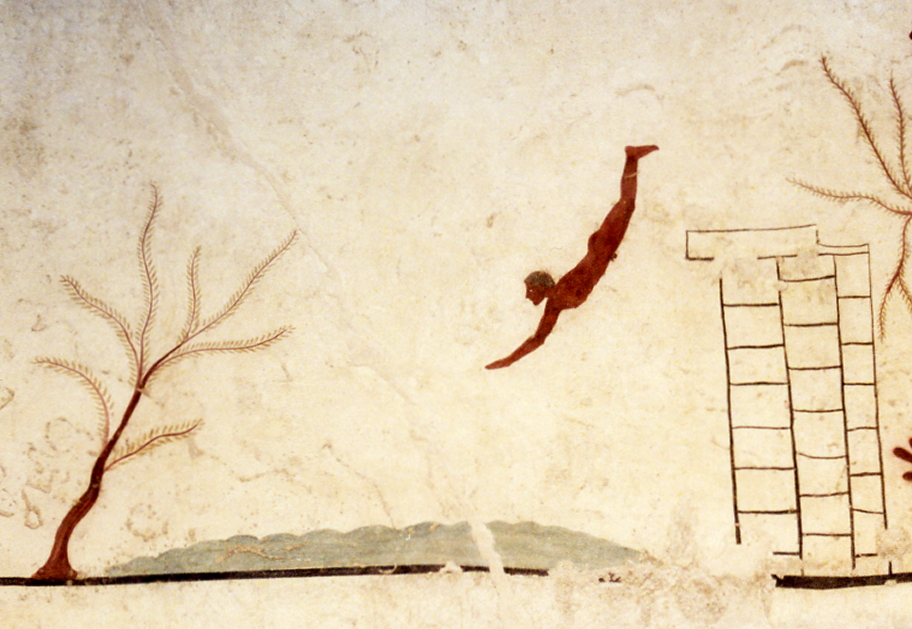
winter trees incline
a wall disappearing
thru air, a sea of time
between plaster and eternity
new grace and cold Hades
the fervent diver
hung in the museum
next to a fire extinguisher
still but for sunmote, featherfall
and the long rectangle of metaphor.
Image: inside decoration of the cover plate of the Tomb of the Diver c/- Wikimedia commons. Linked to Dverse, the poets’ pub where Kim is hosting and asks for a quadrille using the word ‘blue’
The Tomb of the Diver is an archaeological monument, built in about 470 BCE and found by the Italian archaeologist Mario Napoli on 3 June 1968 during his excavation of a small necropolis about 1.5 km south of the Greek city of Paestum in Magna Graecia, in what is now southern Italy. The tomb is now displayed in the museum at Paestum. This wonderful image forms to the inside top of a tomb for a young man of an aristocratic family living in Hellenistic Southern Italy.
And since we’re talking eternity, here’s J.S Bach’s English Suites – played by Murray Perahia (sorry, just skip the ads – something new from Youtube 😶).
Beautiful art, made more beautiful by its context. Bach is a spellcaster. As to the ads, when I use Chrome as my browser the ads are there. If I go back to my trust firefox, there are no ads.
LikeLiked by 1 person
Love the history lesson…. and the irony. Great write.
LikeLike
Lovely. It’s ghostly light and gentle, drifting over the years like the ‘sunmote, featherfall’, and the feeling it brings is an archaic echo of our own. Purer maybe, less sophisticated.
LikeLiked by 1 person
Thanks Jane, it’s a wonderful fresco – and yes speaks across time to us.
LikeLike
Ancient art gives me the shivers.
LikeLike
Gorgeous poem response. Thanks for the music and your added note
Much💙love
LikeLike
Thank you so much, glad you enjoyed. Peter.
LikeLike
The fresco is beautiful in its simplicity and amazing for its age, and thank you for the background story, Peter. I was fascinated by archaeology as a teenager, mainly inspired by a history teacher whose father was an archaeologist who used to take her on digs. And thanks also for the Bach!
I enjoyed the setting of the scene with the winter trees and love the idea of ‘a sea of time / between plaster and eternity’. I also love the isolation of the line ‘the fervent diver’, which makes it stand out in the way the fresco should stand out in the museum, instead of hanging next to a fire extinguisher. The final lines are stunning!
LikeLike
I admire the last line: the long rectangle of metaphor.
This is a wonderful capture of that historical piece. I appreciate the backgrounder.
LikeLike
Wonderful artwork! I so enjoyed reading your poem as well as the background 😀
LikeLike
This is lovely–the image from the past existing in the present–suspended in flight and in time.
I love how you added the prosaic details about the fire extinguisher. This poem does not seem constrained at all by the word count.
LikeLiked by 1 person
Thanks so much Merril, glad you enjoyed.
LikeLiked by 1 person
Image and words with conjunctions and echoes. It’s hard to gauge the width of a metaphor. Is it a blink from a feathered tree to a feather, from one arch to another, from Hades to a sunmote? Peter, thanks for an enjoyable break from the less enjoyable world.
LikeLike
Wonderful poem, and history. Thanks for sharing this with us.
LikeLiked by 1 person